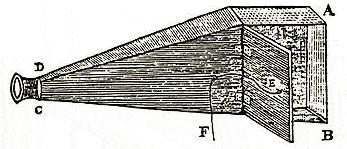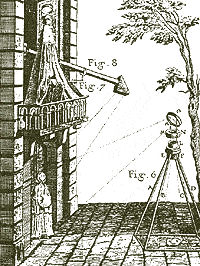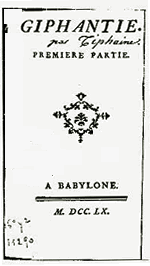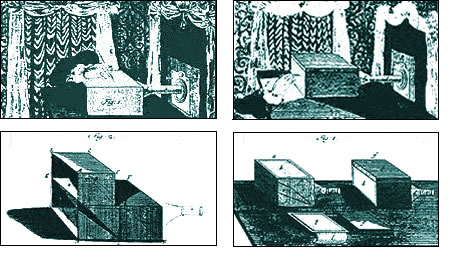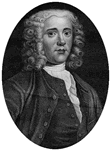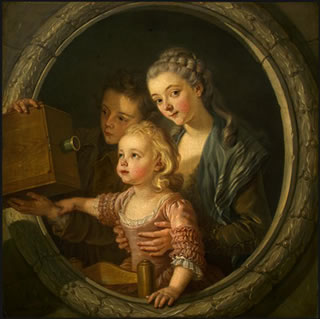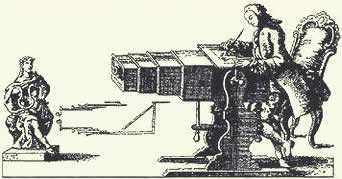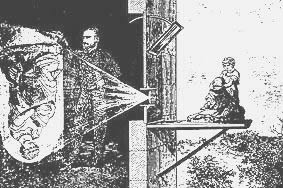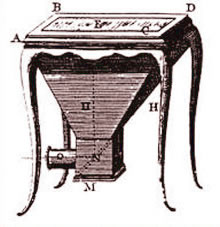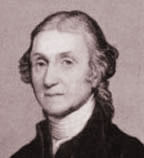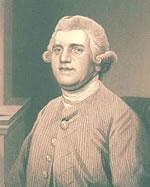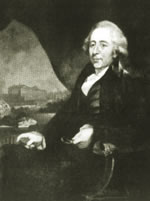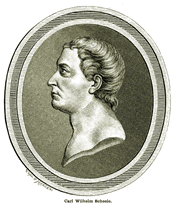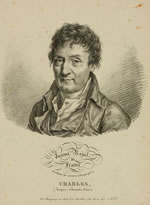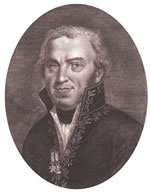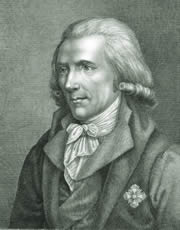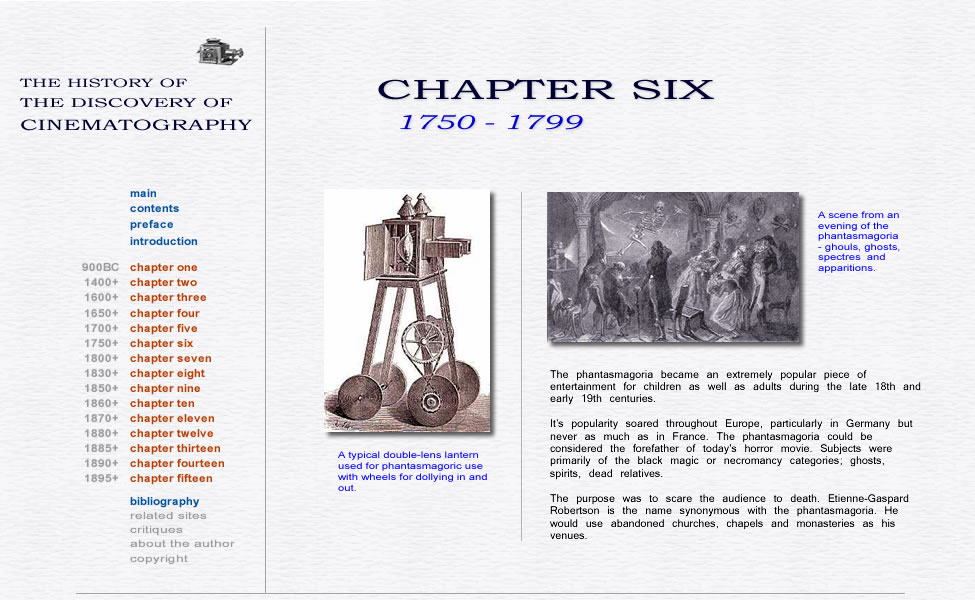 |
| |
|
|
|
| |
|
|
|
| |
|
|
|
| |
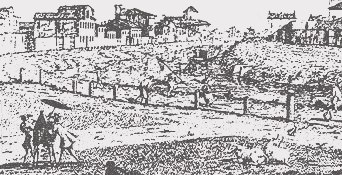 |
1750
GIANFRANCESCO COSTA (1711 -1772)
An
interesting engraving comes to us by way of Costa who shows a portable
tent camera standing on what appears to be four legs, in his book
‚€˜Delicie del Fiume Brenta‚€™. The portable camera is attended
to by two people who are rendering a drawing from across a canal,
of a church and row of houses.
Costa's
engraving from 1750 (left) depicting the open-air use of
a tent camera obscura. Two people appear to be manipulating the
camera in gathering a view of the community along a canal. This
'on location' illustration comes from Costa's book ‚€˜Delicie
del Fiume Brenta‚€™. |
|
|
| |
|
|
|
| |
|
|
| |
|
|
|
| |
1752
JOHN HINTON ( - )
Although
not the inventor, Hinton published an illustration of a room camera
obscura in his publication, ‚€˜Universal MagazineOf Knowledge
And Pleasure‚€™.
Hinton's
illustration (right) from his 'Universal Magazine'.
|
|
|
|
| |
|
|
|
| |
|
|
| |
|
|
|
| |
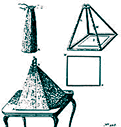 |
1752
ABB√‰ NOLLET (1700 - 1770)
Nollet
made a camera obscura (as did many others) not only portable, but
also collapsible. The portable camera obscura had to this point
become a necessity to travelers and those active out of doors. Just
like today, a camera was then becoming something that you would
not leave home without. This collapsible camera obscura of Nollet
is unquestionably similar to one made by a Mr. Thompson who is spoken
of by Joseph Harris in 1775. |
| Abbe
Nollet received a patent for this camera obscura (left) after submitting
the design to the French Royal Academy of Sciences in 1752. This
was a collapsible camera with a pyramid frame. The upper left diagram
shows it in it's collapsed state. |
|
|
| |
|
|
|
| |
|
|
| |
|
|
|
| |
1753
SIMON PARRAT ( - )
Parrat
described a 'Showbox' in a letter sent to the
‚€˜Gentleman's Magazine‚€™. As Parrat was describing the use
of this instrument in great strides, it is unclear whether he himself
built it, or was simply praising it. Easily converted into a camera,
it was typically used for viewing drawings or engravings. |
|
| A
showbox of questionable origin (right). We do know that Parrat,
an Englishman, knew of this instrument, but whether he built it
is another question, and not answered here. This showbox for viewing
engravings and the like, could be converted to become a camera obscura
as well. The lens was located at (CD) and an image was viewed at
the back (AB) by pulling the string (F) to open the door (E). In
all it would be about 32 inches long, and 12 inches square at the
back. Parrat told of it in a letter sent to the Gentlemen's
Magazine, 1753. |
|
|
| |
|
|
|
| |
|
|
|
| |
 |
A room camera obscura
illustration from 1754 (left). This engraving appeared in
the New Complete Dictionary by Middleton and reminds
us of the showmen of the 14th and 15th centuries, as well as Edward
Scarlett's camera obscura projection into his shop. |
|
|
| |
|
|
|
| |
|
|
| |
|
|
|
| |
1755
ABB√‰ NOLLET (1700 - 1770)
Another
portable camera obscura comes to us again by Nollet. This one is
illustrated as a tent camera that even though portable, can be used
well even at home.
Nollet's
tent camera obscura (right) of 1755. The statuette under
the balcony acts as subject to the artist in the tent (balcony).
The telescopic lens-arm hanging over the balcony reflects the image
through the tube and into the tent from the top. The four-legged
tent on the ground (bottom right corner) shows us how the contrivance
appears in it's uncovered state. |
|
|
|
| |
|
|
| |
|
|
| |
|
|
|
|
|
|
|
| |
1756
LEONARD EULER (1707 - 1783) |
|
|
| |
The first reference found
of the use of the Megascope for projection is by the
German physicist Euler. In projecting opaque objects for Phantasmagoria
shows, the Megascope lens was used in conjunction with the Fantascope.
Today this application is known as an Episcope. The inspiration
for this technique came from Charles. SEE MOISSE
FANTASCOPE |
|
| |
|
|
|
| |
|
|
|
| |
1758
JOHN DOLLOND (1706 - 1761) |
|
|
| |
Dollond, an optician,
improved upon the camera obscura especially in the area of lens construction
by manufacturing an achromatic lens which corrected fringes in colour
and allowing a much clearer picture. He achieved this through the use
of a crown glass lens and a flint glass lens. This method was found to
ignore chromatic aberrations. Dollond manufactured camera obscuras. |
|
| |
|
|
|
| |
|
|
|
| |
1760
CHARLES-FRANCOIS TIPHAIGNE DE LA ROCHE (1722 - 1774) |
|
|
| |
| De la Roche
wrote a book called 'Giphantie' in which he expounded
on a series of imaginary scenes. One, that of the main character
being taken in a typhoon, arrives in a land where he is shown wondrous
things were pictures are ‚€œmade‚€Ě.
A portion of the tale has his host telling how this is done, and
is as follows; |
| |
|
‚€œYou
know, that rays of light reflected from different bodies form
pictures, paint the image reflected on all polished surfaces,
for example, on the retina of the eye, on water, and on glass.
The spirits have sought to fix these fleeting images; they have
made a subtle matter by means of which a picture is formed in
the twinkling of an eye. They coat a piece of canvas with this
matter, and place it in front of the object to be taken. The first
effect of this cloth is similar to that of a mirror, but by means
of its viscous nature the prepared canvas, as is not the case
with the mirror, retains a fac-simile of the image.
The
mirror represents images faithfully, but retains none; our canvas
reflects them no less faithfully, but retains them all. This impression
of the image is instantaneous. The canvas is then removed and
deposited in a dark place. An hour later the impression is dry,
and you have a picture the more precious in that no art can imitate
its truthfulness.‚€Ě |
|
| |
| One
wonders which of the many examples of the past, (Statius, Villeneuve,
Cardano, Porta, et al) De la Roche may have drawn from, telling
this story. One element however is still unexplained. That is, what
‚€œthis matter‚€Ě is referring
to, in the coating of the canvas. La Roche was a doctor who wrote
many philosophical romances in the 18th century using alchemy and
magic as themes within science. Illuminism and Rationalism pre-date
his work and clearly influenced it. Like Verne, Orwell and others,
he foresaw the coming of inventions such as photography and motion
pictures. |
The
title 'Giphantie' was in fact an anagram of De La Roche's middle
name 'Tiphaigne'. |
Cover of Giphantie
(above)
|
|
|
| |
|
|
|
| |
|
|
|
| |
|
|
| |
|
|
| |
1760
MARTIN FROBEN LEDERMULLER (1719 - 1769)
A
microscopist in his spare time, Ledermuller wrote ‚€˜Microscopic
Delights Of The Mind And Eye‚€™, 1760. He described and illustrated
several camera obscuras, some of which were designed as solar microscopes
to view insects. Both reflex and non-reflex cameras are illustrated.
Ledermuller's interest in insects-as-subjects came from his status
as government beekeeper.
Ledermuller's
'Microscopic Delights Of The Mind And Eye' provided us
with several illustrations, four of which are included here (right).
The top images show the camera obscura up against a wall, which
could have contained the insects on the other side in some sort
of storage area. |
|
| It
may have been up against a blackened window. The solar microscope
is shown attached. The illustration on the top left depicts a reflex
camera with 45 degree mirror. The top right shows the camera without
the mirror. In the bottom right image we see the apparatus in sections
with the solar microscope attached. The right-most image shows (F)
as a roll of paper inserted between a sheet of glass and frame for
drawing purposes. Ledermuller provided these illustrations in colour. |
|
|
| |
|
|
| |
|
|
| |
|
|
|
| |
|
|
|
| |
ca. 1760
ABBE NOLLET (1700 - 1770) |
|
|
| |
Nollet constructed a children's
toy, which he named a ‚€˜Dazzling, Whirling, Top‚€™. The
amusement itself although not a magic lantern-type instrument, reminds
us of the yet-to-come zoetrope, and revolving wheels. This top of Nollet‚€™s,
when revolving at a fast speed re-created a sense of motion and had the
appearance of being a solid object. Nollet not only encouraged the camera
and lantern in entertainment but also in the use of education. |
|
| |
|
|
|
| |
|
|
|
| |
|
|
| |
|
|
| |
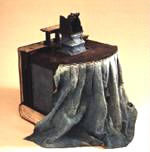 |
1764
BENJAMIN MARTIN (1704 - 1782)
Camera
obscuras came in many forms such as the goblet camera of Herigone.
Martin provided us with a book-shaped camera measuring 24 x 18 x
5 inches in its folded state which he gave to Harvard following
a devastating fire which destroyed the school‚€™s contents. Martin
included with his gifts to Harvard, a camera obscura in the shape
of a brass eye.
The
book-shaped camera obscura shown here (left) is typical of
book camera obscuras of the mid 18th century. The famed portrait
painter Sir Joshua Reynolds (1723-1792) owned this one. It is shown
open for use. (It sits at The
National Museum of Science & Industry). An
engraving of Benjamin Martin (right) from the Encyclopedia
of London 1815. |
|
|
|
| |
|
|
| |
|
|
| |
|
|
|
| |
|
|
| |
1764
CHARLES A. PHILIPPE VAN LOO (1705 - 1795)
An
adorable painting of a camera obscura poking it‚€™s way into the frame
comes to us by way of Van Loo. The subjects are actually the artist‚€™s
family, who are overshadowed by the instrument. A fascinating study
of perspective and dimension, the painting named, "The Magic
Lantern‚€Ě is rather mis-named. It shows a young boy in the
background looking into the lens while embracing the camera, and
a little girl in the foreground with her hand on the frame with
fingers outside of what would be the natural boundaries of a posed
environment. The camera although half in the picture, is clearly
not a magic lantern, but appears from the left as if ‚€œentering‚€Ě
into the view. This added ‚€˜3rd‚€Ě dimension reminds us of the natural
environment the camera obscura provided to artists. The wooden box
and lens are not peculiar to a lantern, and there appears to be
no chimney. However, the circular frame is typical of the shape
of lanternslides. It is unclear why Van Loo called the painting
as he did. This historian has suggested that the view we see is
in fact that of a lanternslide as it would appear in painted form,
thus the name, and the slight humour in blending the two discoveries
in the same picture. It is not known if Van Loo painted lantern
slides. The painting resides in the National Gallery of Art, Washington.
|
|
| Van
Loo's mis-named painting (right) of 1764, "The Magic
Lantern". Clearly the instrument is a camera (having no
characteristics to that of a lantern), even to the novice student.
The portrait of Van Loo's family represents the finished work of
the camera obscura, as opposed to the lantern. It's obvious Van
Loo never used the camera in his art. |
|
|
| |
|
|
| |
|
|
| |
|
|
|
| |
|
|
|
| |
1769
GEORG FRIEDRICH BRANDER (1713 - 1785)
Brander
was German, and published a book, ‚€˜Beschreibung dreyer Camerae
Obscurae‚€™ (Augsburg, 1769) in which he illustrated
a ‚€˜desk‚€™ camera obscura capable of allowing the ease of large drawings.
The apparatus which one could actually sit at was at least 4 feet
high with an extended aperture, which appears to be of equal length.
The artist would sit like as to write a letter and see the subject
before him through the aid of a 45¬į mirror within the camera. Brander
was a student in mathematics and physics at Nuremburg and later
wrote several books on the camera obscura. He edited ‚€˜Beschreibung
dreyer Camerae Obscurae‚€™ twice, in 1775 and 1792. |
|
| Georg
Friedrich Brander provided us with this (right) large and
very practical desk camera obscura illustration from his ‚€˜Beschreibung
dreyer Camerae Obscurae‚€™ of 1769. One could just imagine
the view through the desktop as the artist rendered his subject.
It stood approximately four feet high with a similar length. The
extentions seen housing the aperture allowed for close-ups or telephoto
images. Likely, in this drawing the artist had a close-up of the
subject with a head and shoulders picture, the lens being extended
as it is. |
|
|
| |
|
|
| |
|
|
| |
|
|
|
| |
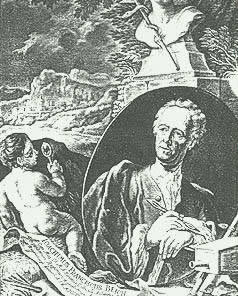 |
ca. MID
18TH CENTURY
GEORGES DESMAREES (1697 - 1776)
Another camera obscura
finds its way into a painting (bottom right corner) by Desmarees,
of German artist Joachimus Franciscus Beich. The portrait of Beich
shows another ‚€˜painting within a painting‚€™ with a cherubim with
a magnifying glass looking at the subject who appears within an
almost circular frame (magnified image typical of a zoom lens).
The camera obscura is found outside this frame, in the bottom right
of the picture as a reminder of it‚€™s abilities to enlarge. A mezzotint
engraving of this exact painting is found at George Eastman House
in Rochester New York. It is said by Coke (One Hundred Years
Of Photographic History, Essays In Honour Of Beaumont Newhall, Edited
by Van Deren Coke, University of New Mexico Press, Albuquerque,
p130) that the camera obscura in this painting is of the same
make used by Caneletto, (original constructed by Venetian optical
instrument maker, Selva). The one in the painting is a German model.
|
| Desmarees'
painting (above) of Beich provides us with a splendid view
of a small camera obscura outside the portrait itself. The juxtaposed
portrait would indicate a subjective view of what the camera sees.
And the magnifying glass in the child's hand? Perhaps it suggests
the ability of the camera to enlarge the image. |
|
|
| |
|
|
| |
|
|
| |
|
|
|
| |
|
|
|
| |
18TH CENTURY |
|
|
| |
During the 18th Century
and the first half of the 19th, the camera obscura was embraced more by
artists than by scientists. It was encouraged to be used for drawing,
sketching and painting. Masters such as Caneletto and Vermeer were often
linked to the camera obscura and controversies have arisen due to this
point. |
|
| |
|
|
|
| |
|
|
|
| |
|
|
| |
|
|
| |
ca.
1770
MEGASCOPE
The
Megascope was a camera obscura which was able -
through the use of a larger lens - to make large scale images of
smaller objects. The Megascope became fairly popular
in the 18th and 19th centuries. Additional mirrors were used to
supremely illuminate the subjects. A focal length of plus 30 inches
were typical. In 1872 Guillemin will publish his ‚€˜The Forces
Of Nature‚€™, outlining the megascope along with illustrations
(The Forces of Nature, A. Guillemin, 1872, London).
|
|
| One
of Guillemin's illustrations from his book 'The Forces of
Nature', published in 1872. The megascope shown here (above)
reminds us of a typical room camera obscura except that the focal
length (sometimes longer than 30") was great enough to fill the
room inside. Notice an exterior mirror at a 45 degree angle downward
to illuminate the subject (a simple lighting effect still used today
by television and film crews). In or around 1770 the megascope began
to appear in books and journals. |
|
|
|
|
|
|
| |
|
|
|
| |
1770
ABB√‰ GUYOT ( - )
Publishes
his ‚€˜Nouvelles Recr√©ations Physiques et Math√©matiques‚€™
(Paris, 1770) with an illustration (vol. 3, plate
20) of an upside down pyramid camera obscura with legs, or,
a table camera obscura. The instrument was said to be 2 feet high
and had it‚€™s lens about 2-3 inches off the ground. It could have
been used for outdoor scenes, placed close to a window. If the
curtains were drawn, this would allow enough darkness for a more
brilliant screen. It might also allow for secrecy in that the
subject may not know they were being sketched. Hooper, in 1787
will describe this apparatus in 'Rational Recreations‚€™.
Guyot's
table camera obscura (right) of 1770. The surface viewing
area received the projected image from below with the lens about
2 inches off the ground. Perhaps the camera was a simple novelty
for guests or a conversation piece. Of course, it could also be
used for drawing. The illustration appeared in Guyot's
‚€˜Nouvelles Recr√©ations Physiques et Math√©matiques‚€™.
|
|
|
|
| |
|
|
|
| |
|
|
|
| |
 |
ca. 1770
THOMAS SHERATON (1751 - 1806)
This
furniture maker in London produced what could be the smallest camera
obscura yet known of. Measuring just 2 x 3 x 3 inches, this supposed
gift was a box within a box. The smaller, inner box slid out of
the larger one, allowing a focus. The lens was in the larger, outer
box and fixed.
The
English furniture maker Thomas Sheraton made a somewhat intricate
pocket camera (left) in or around 1770. Along with the camera
in the handle of a cane, and Herigone's goblet, this camera obscura
is one of the smallest to date. |
|
|
| |
|
|
| |
|
|
| |
|
|
|
| |
|
|
|
| |
1770
JOHANN GEORG SCHROPFER (1730 - 1774) |
|
|
| |
This German, in Lepzig,
began using phantasms and the like in some presentations which preyed
upon the superstitious. Eighteen years later Robertson would gain notoriety
for the very same magic lantern shows using smoke, mirrors, mobile lanterns
and multiple lanterns. Schropfer was a necromancer who eventually committed
suicide. He practiced witchcraft and persauded many to follow him into
the occult. |
|
| |
|
|
|
| |
|
|
| |
|
|
|
| |
1772
JOSEPH PRIESTLEY (1733 - 1804)
Finished and published
his ‚€˜History and Present State of Discoveries Relating
to Vision, Light and Colours‚€™. He states that Kircher
did ‚€œmore conveniently‚€Ě
in the night, what Porta did in the day. He gave inventors credit
to Porta, describing his ‚€œtheatrics‚€Ě
in introducing the camera obscura into history. Priestley is
noted as the discoverer of; graphite (carbon) being a conductor
of electricity; carbon dioxide; soda; nitrus oxide; oxygen;
photosynthesis; and the eraser made from India gum (coining
the phrase 'rubber'). |
|
|
|
| |
|
Joseph
Priestley |
|
| |
|
|
|
| |
|
|
| |
|
|
| |
 |
PHANTASMAGORIA
The Phantasmagoria
became an extremely popular piece of entertainment for
children as well as adults. It‚€™s popularity soared throughout Europe,
particularly in Germany but never as much as in France. Born of
a combination of the Shadowplay, the magic lantern
and the desire to deceive or trick, the Phantasmagoria
could be considered the forefather of today‚€™s horror movie. Its
basic purpose was to produce through simple techniques, an illusion.
Subjects were primarily of the black magic or necromancy categories;
ghosts, spirits, dead relatives or personalities and politicians.
The purpose was to scare the audience to death. Techniques included
the use of smoke, the Shadowplay, use of two or
more magic lanterns, rear projection, hidden projection, projection
on glass, use of mirrors, projection from below the stage, movement
of the lantern (hidden) offering the illusion of subject-motion
and many other ingenious moves.
(Image Courtesy Toronto Reference Library)
ITINERANT TRAVELLING
SHOWMEN
Magic
lanterns also played a part in certain conjuring shows put on by
travelers well versed in such trickery. There are reports dating
back to antiquity which suggest that such tricks were known using
other mediums. Such showmen were common in the streets of European
cities during the 18th and 19th centuries. The great magician Robertson
had at the time of the French Revolution, an elaborate system which
made the effigies of the dead appear to his stunned audiences. He
compensated the movement of the lantern (s) by changing the position
of the lens and thereby was able to show a figure growing larger
and remaining in sharp focus throughout the show. In this manner
he obtained the compelling impression of an approaching figure.
|
| Dissolving
Views within the magic lantern would become an important
fare of the traveling man in the next century. Traveling from city
to town, the traveling magic lantern showman was a virtual cinema
on legs. He carried his lantern, oil, slides and stories with him
on his back. Sometimes traveling in pairs in order to share the
audio/visual element of the program and to attract more patrons,
their shows were known as Galantee So. This the English
title given, comes from the meaning of a 'fine show'. Only
the 'show' part was mispronounced through the accent of the showman
to come out as 'so'. Catching on more and more as the century
wound down, slide shows of the traveler were mostly as those of
the static lantern found in homes of the time; Biblical themes such
as Judgment Day, Noah, Christ on the cross and a vivid hell for
the cheater. |
|
|
| |
|
|
| |
|
|
| |
|
|
|
| |
|
|
|
| |
1772
FRANCOIS DOMINIQUE SERAPHIN (1747 - 1800) |
|
|
| |
One man, Francois Seraphin,
was one of the first to bring the Shadowplay into France.
He called it the ‚€˜Ombres Chinoises‚€™. Seraphin performed
before royalty which was at that time, a very popular and inviting venue.
His first performances of deception were at the Palace of Versailles.
His shows lasted through the French Revolution and into the next century.
Marionettes, a French entertainment-art, had dominated
France until this time as the number one form of movement re-creation
in artistry, and never would regain its hold on audiences as it had. The
magic lantern and the phantasmagoria would for the next one hundred years
hold that title, until the coming of cinema in 1895, at another French
venue, the Grand Cafe in Paris. |
|
| |
|
|
|
| |
|
|
|
| |
|
|
| |
|
|
| |
1773
JOSIAH WEDGEWOOD (WEDGWOOD) (1730 - 1795)
Father of Thomas, this
famous maker of pottery introduces the camera obscura into the
Wedgewood home.
|
|
|
|
| |
|
|
|
| |
|
|
|
| |
|
|
| |
|
|
|
| |
1773
J. H. LAMBERT (1728 - 1777) |
|
|
| |
Lambert wrote ‚€˜Nouveaux
Memoires de l‚€™ Academie Royale‚€™ in which he documents the use
of the camera obscura to record cloud height. A German physicist, Lambert
found a scientific use for the camera which was rare, or at least, poorly
documented. Previously, cloud height had been detected through observance
of the shadows on the ground. |
|
| |
|
|
|
| |
|
|
|
| |
1775
JOSEPH HARRIS (1702 - 1764) |
|
|
| |
Harris wrote ‚€˜Treatise
of Optics‚€™ but it was not until this year that it was published,
after his death (London, 1775, 2nd Book, pp 269-282). It describes
using many fine depictions, the image made with a lens. Besides telling
how one could make a camera, and the uses of the ox-eye lens, Harris also
suggests the ‚€œpocket camera‚€Ě with
a lens of 1 1/2 inch focus which could be fitted to the handle of a cane. |
|
| |
|
|
|
| |
|
|
|
| |
|
|
| |
|
|
|
| |
1777
MATTHEW BOULTON (1728 - 1809)
There are many commentaries
of which suggest that Boulton may have produced photographs
at his establishment, Boulton & Watt, this year. Jerome Harrison
for one, states in his ‚€˜A History Of Photography‚€™,
(Scovill, New York, 1887) these were of the aquatint
process, mechanically produced on metal, large scale, 4 feet
by 5 feet, and coloured (p13, ch. 2). Harrison further
states that this process was that of an employee of the factory,
one Mr. Francis Eggington, inventor. Boulton‚€™s grandson will
discredit these claims however, in a pamphlet published in 1865.
It should be noted that Francis Eggington in his own right became
well known for his work in enamelled glass and stained glass,
as well as his work alongside Boulton in reproducing oil paintings
using a mechanical process. |
|
|
|
| |
|
Matthew
Boulton |
|
| |
|
|
|
| |
|
|
| |
|
|
|
|
|
|
|
| |
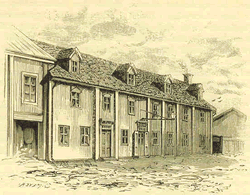 |
1777
CHARLES (CARL) WILLIAM SCHEELE (1742 - 1786)
Scheele was considered
a great chemist, and had been working with silver chloride and
sunlight. He found and proved that the different hues of the
spectrum had substantially different effects on silver when
exposed. He noted that the darker colours such as purple and
blue turned silver chloride darker and faster, than red or yellow.
Scheele also confirmed the fact that light is what affects the
nitrate base, and not heat, as has been suggested and believed
to this point by some. Even beyond this point in time, there
were some who continued to document heat to be the agent in
action, regarding silver salts and the like SEE
1798 RUMFORD |
|
|
|
| |
Scheele's Home Pharmacy
& Laboratory |
Charles
W. Scheele |
|
| |
|
|
| |
|
|
| |
|
|
|
| |
|
|
|
| |
 |
1778
WILLIAM STORER ( - )
William
Storer was an English instrument maker. He produced a camera obscura
of such technical superiority that it was named the Royal
Accurate Delineator. Utilizing rack and pinion motion,
Storer‚€™s camera contained two boxes, one sliding within the other
and had two lenses in the aperture. A third lens allowed for a
brilliant picture and clear focus, however the depth of field
was lessened. A Storer Delineator resides at the Science Museum,
London.
A
William Storer camera obscura 'delineator' (left) of
1778. |
|
|
| |
|
|
|
| |
|
|
| |
|
|
|
| |
|
|
| |
1780
JACQUES ALEXANDRE CESAR CHARLES (1746 - 1823)
Charles was commissioned
by Louis XVI to construct (at the Louvre in Paris) a projection
machine known as a Magascope which would project
images of people onto a wall.
Charles is also known
in history as the man who invented the hydrogen balloon. |
|
|
|
| |
|
Jacques A. C. Charles |
|
| |
|
|
|
| |
|
|
| |
|
|
|
| |
1781
PHILIPPE JACQUES DE LOUTHERBOURG (1740 - 1812) |
|
|
| |
In 1781 Loutherbourg,
an accomplished painter, put the finishing touches on what he called an
Eidophusikon which attempted to present motion through
the presentation of successive pictures. Based loosely on the camera obscura
room and it's ability to entertain crowds, and leaning more towards the
Panorama and Diorama, the Eidophusikon was first
set up in a room in his house. Guests would peer through an aperture no
less than 6 feet square to see pictures painted on fine tafata with colours
which were translucent. Light was projected from behind at different distances
depending on the desired effect. Reflecting mirrors were added to define
the scenery with brilliance and life.
In his Musical Memoirs of 1830, Parke would comment on
the Eidophusikon as the ...."newly
invented transparent shades upon which was shed a vast body and brilliancy
of colour producing an almost enchanting effect." A darkened
auditorium aided Loutherbourg in setting a mood consistent with the program,
and agreeable to the audience. It would be another hundred years however,
before patrons would sit in theatres with only the screen/stage lit. Loutherbourg's
first showing was that of an early morning scene of London. |
|
| |
|
|
|
| |
AUTHOR'S
NOTE:
Loutherbourg has also been associated with the names Lauterbourg
and Lutherbourg. Adolf Hübl in a 1947 published work was
announced by the German film director Werner Wekes as a post-biblio 'source'
for his 1986 documentary on the prehistory of cinema, and links Loutherbourg
as the inventor of the Flip Book in 1760. No other reference
has been found. |
|
| |
|
|
|
| |
|
|
|
| |
|
|
|
| |
|
|
|
| |
1784
FRANCOIS DOMINIQUE SERAPHIN (1747 - 1800) |
|
|
| |
Begins performing his
Shadowplays at the Palais Royale in Paris. The magic
lantern had grown in such popularity as a form of contemporary entertainment,
that the Royal court was now the ultimate venue. |
|
| |
|
|
|
| |
|
|
|
| |
1784
ETIENNE - GASPARD ROBERT (1764 - 1837) |
|
|
| |
Robert, from Belgium,
changed his name early on to the lengthier Robertson. He maintained this
stage name for the most part, throughout his entire life and was well
known as E.G. Robertson the master of the Fantasmagoria.
Robertson probably did more for the art than any other magician, performer
or showman. His Fantasmagoria grew out of an early interest
in and love for magic, or more importantly, optics. A professor of physics
in his native Liege, he states in his memoirs that he read the works of
Porta and Kircher et al, and began on the road to horror by devising what
would become the most prolific entertainment of the late 18th and early
19th centuries. In 1784, Robertson gave an exhibition of an improved magic
lantern. He was greatly influenced by the earlier work of Musschenbroek‚€™s
motion attempts, and had been impressed with the works of the Shadowplay
artists including Seraphin, a decade earlier in Paris. Robertson headed
towards Paris with his ‚€˜Fantomes Artificiels‚€™ (Artificial
Fantoms). |
|
| |
|
|
|
| |
|
|
|
| |
ca. 1785
GIUSEPPE BALSAMO (1743 - 1795) |
|
|
| |
Also known as ALESSANDRO
CONTE DI CAGLIOSTRO or COUNT CAGLIOSTRO, this Italian itinerant traveling
showman and perhaps charlatan, was known for using Fantasmagoric
imagery and Shadowplays of a deceptive nature in order
to deceive patrons and was jailed several times. Balsamo became quite
popular throughout Europe, and well known we might add. |
|
| |
|
|
|
| |
|
|
|
| |
|
|
| |
|
|
| |
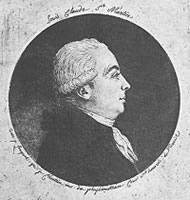 |
1786
GILLES LOUIS CHRETIEN (1754 - 1811)
Produced
his process of making multiple ‚€œsilhouettes‚€Ě which he called a ‚€˜Physionotrace‚€™.
As was the silhouette, an outline of the subject was made along
with a matching copper engraving. The copper plate was then used
for reproductions. (SEE 1687 MARCO ANTONIO
CELLIO for similarities in copperplate etchings).
This
portrait of Chretien was made in 1792. The Physionotrace
was invented by Chretien in 1786 and produced a product similar
to the silhouette in appearance. It also allowed the user to trace
smaller etchings and engravings. |
|
|
| |
|
|
| |
|
|
| |
|
|
|
| |
|
|
|
| |
1787
ROBERT BARKER (1739 - 1806) |
|
|
| |
Barker receives this
year a patent for a new form of entertainment which contained huge painted
pictures. It is recorded on the patent as "an entire new contrivance
or apparatus called by him 'La nature a coup d' oeil' ."
Barker, having spent some time in jail, was said to have needed light
in order to read a letter and came up with the idea of lighting from
above when using a shaft of light falling through a crack. Barker, a
Scottish painter, had seen the work of Loutherbourg and his backlit
spectacles. Barker's entertainment became known as the Panorama.
The Classic Encyclopedia based on the 11th edition
of the 1911 Encyclopaedia Britannica defines the Panorama
and explains it as ... "the name given
originally to a pictorial representation of the whole view visible from
one point by an observer who in turning round looks successively to
all points of the horizon. In an ordinary picture only a small part
of the objects visible from one point is included, far less being generally
given than the eye of the observer can take in whilst stationary. The
drawing is in this case made by projecting the objects to be represented
from the point occupied by the eye on a plane. If a greater part of
a landscape has to be represented, it becomes more convenient for the
artist to suppose himself surrounded by a cylindrical surface in whose
centre he stands, and to project the landscape from this position on
the cylinder. In a panorama such a cylinder, originally of about 60
ft:, but now extending to upwards of 1 3 0 ft. diameter, is covered
with an accurate representation in colours of a landscape, so that an
observer standing in the centre of the cylinder sees the picture like
an actual landscape in nature completely surround him in all directions.
This gives an effect of great reality to the picture, which is skilfully
aided in various ways. The observer stands on a platform representing,
say, the flat roof of a house, and the space between this platform and
the picture is covered with real objects which gradually blend into
the picture itself. The picture is lighted from above, but a roof is
spread over the central platform so that no light but that reflected
from the picture reaches the eye. To make this light appear the more
brilliant, the passages and staircase which lead the spectator to the
platform are kept nearly dark." |
|
| |
|
|
|
| |
|
|
|
| |
PANORAMA and DIORAMA |
|
|
| |
These enormously popular
forms of entertainment were the closest things to an actual movie theatre
in the late 18th and early 19th centuries. They required great artists
who excelled in perspective and large-scale productions. Besides Loutherbourg,
Thomas Gainsborough and Louis Daguerre also provided spectacular scenery.
Daguerre would open the first Diorama in Paris in 1822.
So popular were they that several other 'versions' came out of them. Some
were known as; Pleorama, Giorama, Cyclorama, Betaniorama, Cosmorama,
Kalorama, Kineorama, Europerama, Typorama, Neorama, Uranorama, Octorama,
Poecilorama, Physiorama, Nausorama, Udorama.
The Panorama was unique in the sense that one could not
only see the centre of the picture but also, the peripheral vision could
see as in nature, the outer corners of the view. This gives us the sense
that there is no boundary other than the limitations of the eye itself.
Today's Panorama is of course, the Cinerama,
more commonly known as the IMAX format (IMAX incorporating
height as well as width). The Panorama was also
the precursor of the 1930's and 40's newsreels of the movie theatre. Patrons
could not only see the film but prior to it's beginning, news footage
of recent events, news happenings and the like would be shown fresh from
the battlefield or street scene. In 1812, a Panorama
in Berlin was presenting the burning of Moscow just three months after
it happened. |
|
| |
|
|
|
| |
|
|
|
| |
1790
PIERRE GUINARD ( - ) |
|
|
| |
Guinard greatly advanced
the process of grinding glass into finer lenses for optical use. Guinard
was a Swiss glassmaker. |
|
| |
|
|
|
| |
|
|
|
| |
|
|
| |
|
|
|
| |
1792
ROBERT BARKER (1739 - 1806) |
|
|
| |
Barker makes his first
public presentation of his new Panorama at Leicester
Square, London in 1792. Patrons sat in the centre of a slowly revolving
rotunda, which measured 16 feet high and 45 feet in diameter. The view
was of the British navy moored between the Isle of Wight and Portsmouth
and was named The English Fleet. Shortly thereafter,
Barker toured with his Panorama showing such epics as
View of London, Battle of Aboukir, The Environs of Windsor and Lord
Howe's Naval Victory. While touring in Germany, his show was given
the unfortunate German translation of Nausorama. The Panorama
was as wide as 300 feet and as high as 50. |
|
| |
|
|
|
| |
|
|
| |
1792 Panoramic Painting
From The Top Of St. Giles Church |
|
| |
One of Robert
Barker's 'new contrivance or apparatus called by him 'La nature a
coup d' oeil'. This panorama (above) by Barker is of the
city of Edinburgh. These enormous paintings were a pre-cursor to today's
wide-screen cinema. Edinbugh Castle can be seen to the right. Barker ironically
was also a painter of miniatures. The above Panorama of Robert Barker
is from The Edinburgh Virtual Environment Centre at The University of
Edinburgh and is © the City Arts Centre. it is entitled "Edinburgh
From The Crown Of St. Giles". Thanks to John Hadden.
|
|
| |
View
A Large Format Of This Digitized Panorama Here. |
|
|
| |
|
|
|
| |
|
|
| |
2004 Panoramic
Photograph From The Scott Monument |
|
| |
A superb
modern-day panoramic photograph of Edinburgh from a different vantage
point (immediately above). As Barker's panorama of the late 1790's
was painted from the crown of St. Giles, this 2004 photograph by photographer
John Loughlin was taken from the Scott Monument. Locating the castle on
the horizon off the right border, one can follow the city landscape as
well as landmarks and roads down the Royal Mile. Photograph Source: John
Loughlin |
|
| |
View
A Large Format Of This Digital Photograph Here. |
|
|
| |
|
|
|
| |
|
|
| |
2004 Panoramic
Photograph From The Edinburgh Camera Obscura |
|
| |
This marvelous
panoramic photograph taken by photographer Peter Stubbs is from the Edinburgh
camera obscura. It was taken in 2004 and is more than 360 degrees as Edinburgh
Castle can be seen on both the far left and far right edges. Stubbs used
twelve photogaphs to complete this image. The camera obscura building
can be seen on the far right, above the two lasses. Visit Edin
Photo here for an annotated view. Photograph Courtesy Peter Stubbs
© (www.edinphoto.org.uk) |
|
| |
View
A Large Format Of This Photograph Here |
|
|
| |
|
|
|
| |
|
|
|
| |
|
|
| |
|
|
|
| |
|
|
|
| |
1794
ELIZABETH FULHAME ( - ) |
|
|
| |
A Scot, Fulhame was the
wife of a doctor who had an interest in producing images. Possibly influenced
by her husband, she wrote and published 'An Essay on Combustion:
With a View to a New Art of Dying and Painting' this year. Fulhame
wrote on the need for a 'catalysis' in decelerating the action of light
on silver and gold compounds and conducted experiments on reducing oxidation.
Through her husband Thomas she came into contact with men like Joseph
Priestley. |
|
| |
|
|
|
| |
|
|
|
| |
1794
THE ENCYCLOPEDIA BRITANNICA of 1794 ... |
|
|
| |
. . . provides us with
another book-form camera obscura. This illustration depicts a camera which
when unfolded, appears in the shape of a pyramid. It allows the hand of
the illustrator to be inserted in order to make the drawing. It also had
a knob which could be turned and thus control the lens, allowing a clear
focus. |
|
| |
|
|
|
| |
|
|
|
| |
AUTHOR‚€™S NOTE:
Numerous entries such as this
are found throughout time and therefore are consuming to say the least.
We therefore reserve the right to document those entries we feel are significant
to the theme of this book, and discard others we feel are repetitive or
duplicative, and do not contribute to the meaning of discovery, although
historical. |
|
| |
|
|
|
| |
|
|
|
| |
|
|
| |
|
|
| |
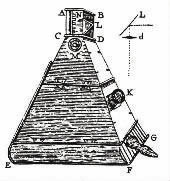 |
Another book camera
obscura with a pyramid-shape when unfolded. This illustration (left)
appeared in the 1794 edition of the Encyclopedia Britannica. In
comparison to Guyot's table camera (SEE ABB√‰ GUYOT)
of 1770, this model is a righted version. The mirror (L) and lens
(d) were stored in the top (ABCD). The base (GFE) took the shape
of the "book" when collapsed and not in use. A knob was located
at (M) [below the top] which could be turned to focus. The viewer
looked through (K) to see the image. A cloth-covered entrance between
(FG) allowed the user to insert the hand if the picture was to be
drawn. |
|
|
| |
|
|
| |
|
|
| |
|
|
|
| |
|
|
|
| |
1796
JEAN-GABRIEL AUGUSTIN CHEVALLIER (1778 - 1848)
|
|
|
| |
Chevallier was optician
to the King as well as an engineer. He was also a manufacturer of scientific
instrument s including optical pieces beginning this year. Chevallier
sold Phantasmagoria magic lanterns including a machine
which could mimic the sounds of thunderstorms. |
|
| |
|
|
|
| |
|
|
|
| |
1796
ETIENNE-GASPARD ROBERT (1763 - 1837) |
|
|
| |
Proposes to the French
government his ‚€˜Miroir d'Archimede‚€™ or Mirrors of
Archimedes and a plan for burning the invading ships of the English
navy. The plan was refused and from this point he concentrated on the
magic lantern and a more entertaining host. |
|
| |
|
|
|
| |
|
|
|
| |
1796
THOMAS WEDGEWOOD (WEDGWOOD) (1771 - 1805) |
|
|
| |
Wedgewood experimented
with silver salts making images of leaves and insects using silver nitrate
on a number of different bases including leather. |
|
| |
|
|
|
| |
|
|
|
| |
|
|
| |
|
|
| |
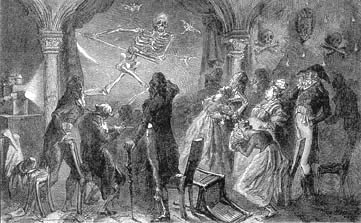 |
1797
ETIENNE-GASPARD ROBERT (1763 - 1837)
Robertson
is given permission to present a magic lantern show within a chapel
on the property of a Capuchin monastery. The chapel was abandoned
and presented as the ideal venue for his phantoms, spectres and
gouls. Robertson used his mobile lanterns (several), smoke, mirrors
and the lively imaginations of the patrons of Paris. He also used
rear projection and projection on gauze that was coated with wax
which he ironed to produce a translucent appearance. |
| Robertson
used a variety of techniques and strategies in order to scare his
audiences to death. His famous show at the monastery near the Palace
Vendome created a stir not lived down too soon. Using huge sheets
of glass, roving lanterns, smoke and mirrors, Robertson became the
talk of Europe and the phantasmagoria soon made its way to North
America. |
|
|
| |
|
|
| |
|
|
|
|
|
|
| |
1797
GIOVANNI BATTISTA VENTURI (1746 – 1822)
Venturi decodes the
mirror writing of Da Vinci and publishes his work showing detailed
and scientific descriptions of the camera obscura and the pinhole
image as seen by Da Vinci (Essai sur les ouvrages phisico-mathematiques
de Leonardo da Vinci, Paris, 1797). Venturi became
professor of geometry and philosophy at the University of Modena
in 1773 and physics in 1776 also at Pavia.
In 1814 Venturi wrote his
'Commentari sopra la storia e le teorie dell'ottica'
(Bologna, 1814) on the history of optics. SEE
DA VINCI 1500 |
|
|
|
| |
|
Giovanni
Battista Venturi |
|
| |
|
|
|
| |
|
|
| |
|
|
| |
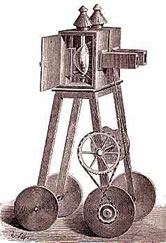 |
1798
ETIENNE-GASPARD ROBERT (1763 - 1837)
Robertson
presented his first French exhibition of the Fantasmagorie
at the Pavillon de l'Echiquier in Paris. He used
a magic lantern that was on wheels for great effect in motion and
realism. In 1799 he obtained a patent naming the instrument a ‚€˜Fantoscope‚€™.
Robertson
was clearly the early master of the magic lantern phantasmagoria.
His concept of motion-projectors precedes the concept of dollying
and panning, which was born of the cinematographer in the early
20th century.
|
|
|
| |
|
|
| |
|
|
|
|
|
| |
|
|
|
| |
|
|
| |
|
|
| |
1798
COUNT RUMFORD (BENJAMIN THOMPSON) also REICHSGRAF VON RUMFORD
(1753 - 1814)
Presented to the Royal
Society a paper entitled ‚€˜An Enquiry Concerning The
Chemical Properties That Have Been Attributed To Light‚€™.
Rumford claimed that heat caused silver salts to darken under
light and not the light. The Royal Society published this in
their Philosophical Transactions Journal. His
claims were directed towards Charles Scheele who had conclusively
shown the opposite.
During the American
Revolution Rumford took the side of the British. He moved to
Europe living in Germany and England, working with the poor
and continuing his experim ents and studies in heat.
Rumford is known today
for the 'Rumford Fireplace' and also as the inventor of thermal
underwear. The Rumford crater on the moon is named after him.
SEE 1777 SCHEELE |
|
| |
Count
Rumford |
|
|
| |
|
|
|
| |
|
|
| |
|
|
|
| |
|
|
|
| |
1799
ETIENNE-GASPARD ROBERT (1763 - 1837) |
|
|
| |
Robertson applied for
and obtains a patent for his portable ‚€˜Fantoscope‚€™, a
magic lantern on wheels. . . . A representation
of a magic lantern on wheels used for recreating motion during phantasmagoria
shows of the late 18th and early 19th century. |
|
| |
|
|
|
| |
|
|
|
| |
|
|
|
| |
|
|
|
| |
|
|
|
| |
|
|
|
| |
|
|
|

|
| |








